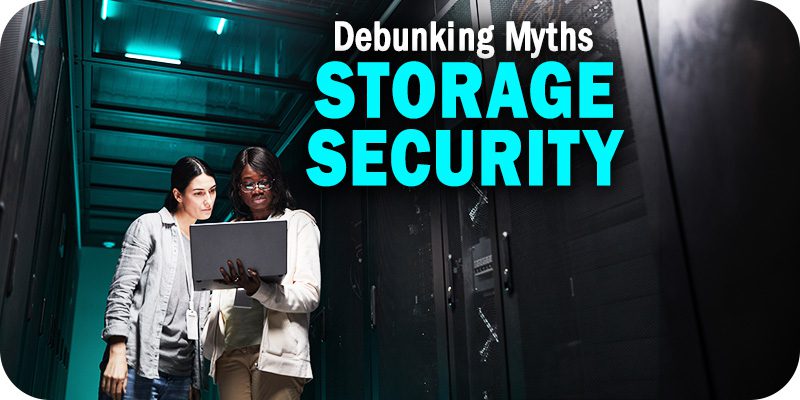Debunking 7 Common Storage Security Myths

The editors at Solutions Review partner up with data storage experts, Continuity, to debunk some common storage security myths.
Debunking storage security myths helps organizations align their security practices with the current threat landscape. The cybersecurity landscape is constantly evolving, with new vulnerabilities, attack vectors, and techniques emerging regularly. By understanding the realities of storage security, enterprises can stay updated on the latest best practices, technologies, and threats. This knowledge enables them to adapt their security strategies and implement appropriate controls to mitigate risks effectively.
Dispelling storage security myths also helps foster a culture of security awareness within the organization. By educating employees about the realities of storage security, organizations empower them to make informed decisions, identify potential risks, and adopt security-conscious behaviors. This proactive approach to security can help prevent security incidents, such as accidental data exposure or falling victim to social engineering attacks, ultimately strengthening the overall security posture of the enterprise.
The editors at Solutions Review look at some of the more common APM myths and break down how they can prove detrimental to you and your team. We’re also recommending looking at Continuity’s The State of Storage Security report to learn in detail how storage security is currently being compromised and what can be done about it.
7 Common Storage Security Myths
Here are some common storage security myths:
- “Encrypting data means it’s completely secure.” Encryption is an essential security measure but doesn’t guarantee absolute security. While encrypted data is more challenging to access without the proper decryption key, vulnerabilities can still exist in the encryption implementation, key management practices, or during data processing when it’s decrypted. Other factors, such as weak passwords or compromised endpoints, can also expose encrypted data.
- “Cloud storage is inherently less secure than on-premises storage.” Cloud storage has gained prominence, and while it introduces unique security considerations, it’s not inherently less secure. Cloud service providers often have robust security measures, including encryption, access controls, and physical security. However, the responsibility for securing data in the cloud is shared between the provider and the customer. Misconfigurations or inadequate security practices by either party can lead to vulnerabilities.
- “Physical storage is safer than digital storage.” While physical storage, such as hard drives or USB drives, may seem more secure, they also have their own vulnerabilities. Unauthorized individuals can lose, steal, damage, or access physical storage devices. Additionally, physical storage does not provide the same level of access controls, encryption, and monitoring options as digital storage solutions.
- “Data backups ensure a complete recovery from any incident.” While backups are crucial for data recovery, assuming they guarantee complete recovery is a myth. If backups are not correctly configured, regularly tested, or stored securely, they can be compromised alongside the primary data. It’s essential to follow best practices for backup storage, including off-site or offline backups, redundancy, and encryption.
- “Storage vendors always prioritize security.” While storage vendors typically invest in security measures, assuming all vendors prioritize security equally can be misleading. Not all vendors have the same level of security practices, certifications, or adherence to best practices. It’s crucial to conduct thorough research and due diligence before selecting a storage vendor, considering their security track record, data protection features, and compliance with relevant standards.
- “Data stored on solid-state drives (SSDs) is immune to data recovery.” SSDs use different technology than traditional hard disk drives (HDDs) but are not immune to data recovery. While SSDs’ data deletion mechanisms differ, data remnants may still exist even after deletion or formatting. Specialized techniques, such as forensic analysis or data recovery services, can potentially retrieve data from SSDs, highlighting the importance of secure data disposal practices.
- “Storage security is the sole responsibility of the IT department.” Storage security is a shared responsibility across an organization. While the IT department plays a vital role in implementing and maintaining security controls, employees, including end-users, must also adhere to security policies, utilize strong passwords, update software regularly, and be vigilant against social engineering or phishing attempts. Storage security requires a collaborative effort to be effective.
It’s essential to separate these myths from reality to make informed decisions about storage security and implement appropriate measures to protect sensitive data effectively. Debunking storage security myths is vital for enterprises to ensure they understand the risks and appropriate measures to protect their data. It enables informed decision-making, alignment with the evolving threat landscape, customer trust, regulatory compliance, and a culture of security awareness. By dispelling these myths, organizations can establish a strong foundation for robust storage security practices and safeguard their valuable assets effectively.
Read Continuity’s The State of Storage Security Report
- Debunking 5 Common SIEM Myths - July 7, 2023
- Identity Management and Information Security News for the Week of June 30; Keyfactor, KnowBe4, Bionic, and More - June 29, 2023
- Debunking 7 Common Storage Security Myths - June 28, 2023




















